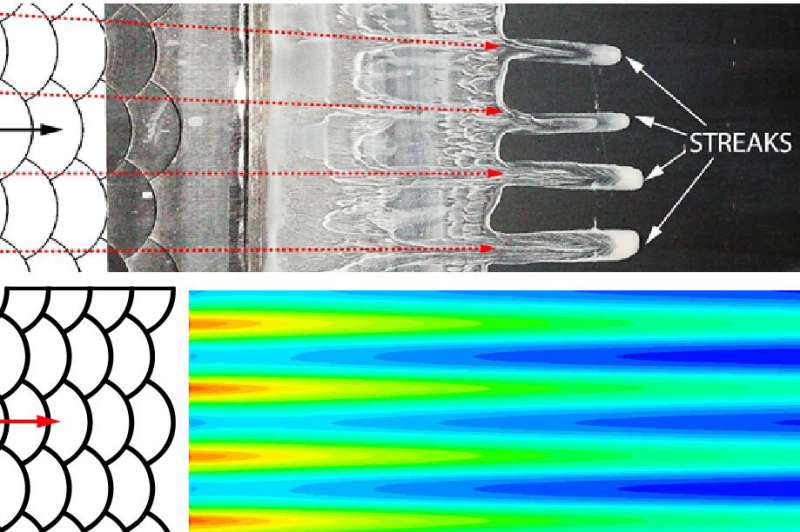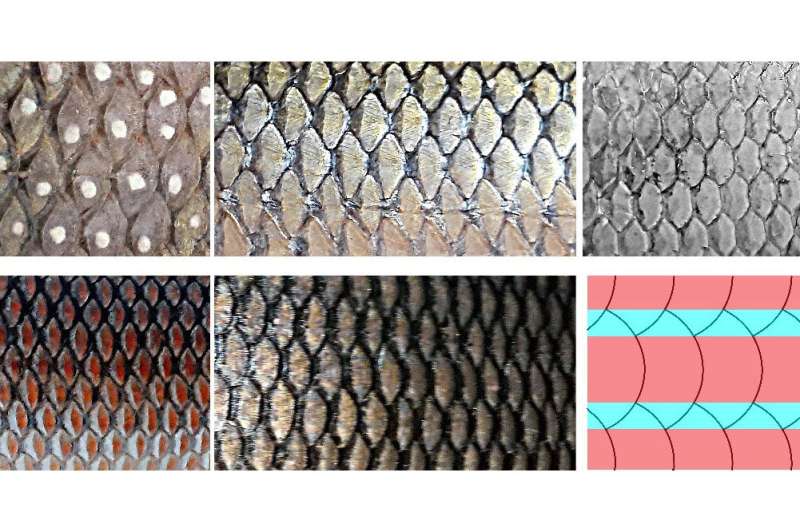Aerodynamicists reveal link between fish scales and aircraft drag

The team's findings have been published in Nature: Scientific Reports: "Transition delay using biomimetic fish scale arrays," and in the Journal of Experimental Biology: "Streak formation in flow over biomimetic fish scale arrays."
Reducing drag means faster aircraft speeds and less fuel consumption—an important area of study for aerodynamicists such as Professor Bruecker, City's Royal Academy of Engineering Research Chair in Nature-Inspired Sensing and Flow Control for Sustainable Transport, and City's Sir Richard Oliver BAE Systems Chair for Aeronautical Engineering.
Through their biomimetic study, Professor Bruecker's team has discovered that the fish-scale array produces a zig-zag motion of fluid in overlapping regions of the surface of the fish, which in turn causes periodic velocity modulation and a streaky flow that can eliminate Tollmien-Schlichting wave induced transition to reduce skin friction drag by more than 25 percent.
An examination of oil flow visualization using computational fluid dynamics (CFD) on sea bass and common carp enabled the authors to come up with a working hypothesis:
"Computation Fluid Dynamics (CFD) was used to study the flow pattern over the surface and revealed a hitherto unknown effect of the scales as a mechanism to generate a regular pattern of parallel streamwise velocity streaks in the boundary layer. To prove their existence also on the real fish skin, oil flow visualization was done on sea bass and common carp, which indeed confirmed their presence in a regular manner along their real body, with the same arrangement relative to the scale array as observed along the biomimetic surface. These results let the authors hypothesize about a possible mechanism for transition delay, inspired by various previous fundamental transition studies, where streaky structures generated by cylindrical roughness elements or vortex generator arrays have shown a delay of transition."

Using the specially equipped laminar water tunnel at the University of Stuttgart in Germany, Professor Bruecker and Professor Rist (University of Stuttgart) have tested the hypothesis of a transition (drag) delay by experimenting with a smooth flat plate and a flat plate covered with biomimetic fish scale arrays.
Their surprising research outcome runs counter to the common belief that roughness promotes by-pass transition. Instead, the scales largely increase the stability of the base flow similar to an array of vortex generators.
A technical realization of such patterns on aerodynamic surfaces will pave the way towards the drastic reduction in fuel consumption and future zero-emission flight.
More information: Muthukumar Muthuramalingam et al, Transition delay using biomimetic fish scale arrays, Scientific Reports (2020). DOI: 10.1038/s41598-020-71434-8
Muthukumar Muthuramalingam et al. Streak formation in flow over biomimetic fish scale arrays, The Journal of Experimental Biology (2019). DOI: 10.1242/jeb.205963
Journal information: Journal of Experimental Biology , Scientific Reports
Provided by City University London




















